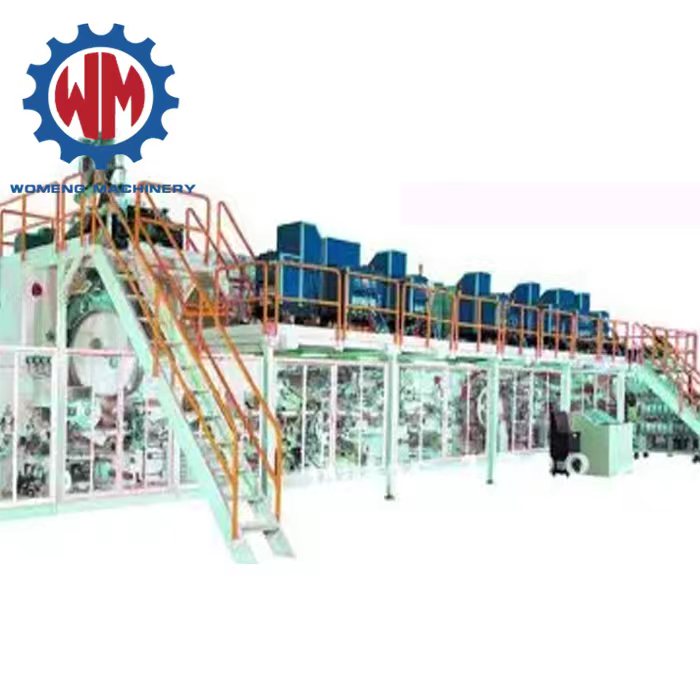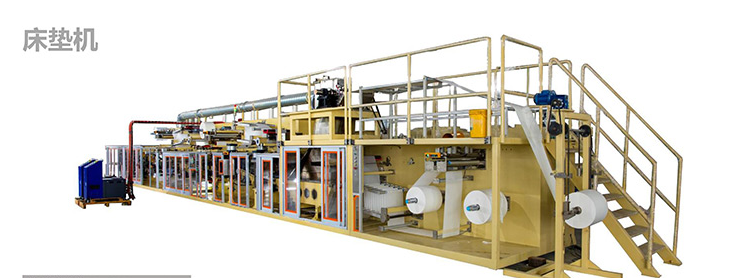Women’s menstrual pain, sanitary napkin advertisements do not know Canada Sanitary napkin machinery
Menstruation is the most basic physiological phenomenon that all women have to experience. However, in the face of this phenomenon, society seems to have long been accustomed to using obscure words to refer to it and describe it with vague language. This inexplicable and unclear sense of “shame” is not only related to the way we talk about menstruation since childhood, but also to the concept of “menstrual shame” implicit in sanitary napkin advertisements and packaging.
The hidden red blood, the gradually shrinking word “sanitary napkin”, the marginalized female advertising image… We use the advertising and packaging of sanitary napkins as the entry point, hoping to get a glimpse of the shame and courage about menstruation.Canada Sanitary napkin machinery
If you’re a woman, you must have carefully hidden a pad, just like me.
Menstruation is a physiological phenomenon that occurs with the periodic changes of the ovary, the periodic shedding of the endometrium and bleeding, and is an important part of the life of half of the world’s people. However, whenever “menstruation” and “sanitary napkins” are mentioned, women are still coerced by indescribable “shame” and use pronouns instead.Canada Sanitary napkin machinery
It is worth noting that in the discussion of related topics, some women said that they used some common nicknames to refer to menstruation only out of habit, not out of shame.
The secret codes and code names for sanitary napkins among women are only part of menstrual shame. What needs to be further asked is: how does menstrual shame arise? How does it relate to sanitary pads and their advertising? How does the media presentation of sanitary napkins discipline women?
We have collected and sorted out 143 domestic TV advertisements of 13 sanitary napkin brands, and analyzed the advertising spokespersons, advertising content, advertiser colors, advertising words and the packaging design of sanitary napkins one by one, hoping to answer our questions. .
Menstrual contraindications: unspeakable menstruation, invisible blood
In the 1870s, the first advertisements for sanitary pads appeared in history, which differed from the current style of sanitary pads, which were reusable pads and were usually sold together with garters. 50 years later, Kojisi started the era of disposable hygiene products and released the first real sanitary napkin advertisement. The main selling point at that time was “easy to hide and easy to carry”, and it was taboo to directly mention sanitary napkins and menstruation. The advertisement copy wrote, “Ask for them by name”. It wasn’t until 1985 that the term menstruation (period) appeared for the first time in a TV commercial for American brand Tampax.
Obviously it is a sanitary napkin advertisement, but it avoids talking about “menstruation”. This tradition continues to this day. Among the 143 advertisements compiled, 97 avoided mentioning the word “menstrual period”, followed by the vague “those days” as a proxy, and only 4 advertisements generously referred to it as a menstrual period .
In addition, 88 advertisements for sanitary napkins did not show blood color, and even if they did, they used blue or green liquid instead. This is related to the “Sanitary Napkin Advertising Self-discipline Rules” (hereinafter referred to as the “Rules”) issued by the China Advertising Association in 2016. Article 4 of the “Rules” stipulates that “the color of the liquid used to demonstrate the absorption of sanitary napkins cannot be red or similar to it. color.” As a result, replacing blood with blue liquid has become a tradition in sanitary napkin advertising, and more advertisements do not appear to simulate the color of blood.
Scholar Guo Jingyi conducted research on the possibility and limitations of sanitary napkin advertisements breaking the menstrual taboo. She argues that the relevant provisions in the Rules will perpetuate the menstrual stigma that menstruation is unclean, filthy and should be hidden. Although the industry self-regulatory code does not equate to mandatory laws and regulations, it actually reflects the norms developed by the industry community such as advertisers and advertising agencies, that is, they also recognize the gender stereotypes and gender norms surrounding menstrual shame.
If there is a taboo, someone must break the taboo. In 2016, Libresse Weir launched the #BloodNormal# campaign around the world. For the first time, a more realistic red liquid represented blood, breaking the long-standing advertising expression method of replacing menstrual blood with blue. After entering China in 2019, Libresse Weier launched the “Renew View of Menstruation” campaign, calling on women to remove their menstrual shame and face up to this normal physiological phenomenon, and boldly used red in advertisements to represent menstrual blood and challenge the stereotypes about menstruation/gender. impression.Canada Sanitary napkin machinery
However, in the case of prioritizing commodity sales, Libresse was inevitably influenced by the local menstrual shame and gender cultural norms in China, and the stance of the breaker gradually converged and became more conservative. In the later advertisements “Do Not Hide Menstruation” and “Tear the Label, Dare Not to Hide”, stars replaced ordinary women, and menstrual blood was no longer represented by red, but simply emphasized the tailoring and function of sanitary napkins, and called on women to “buy them” Buy buy” to support menstruation not hidden.Canada Sanitary napkin machinery
Menstrual Filters: Beautified Women and Menstrual Experience
Under normal conditions, the physiological phenomenon of women’s menstruation will last for about 30 years. At present, the age of menarche for most girls is 12-13 years old (there is an early trend), and amenorrhea is generally between 44-55 years old. However, in sanitary napkin advertisements, the image of women over 35 years old is almost absent, and brands generally prefer young women under 25 years old when choosing spokespersons, and there are no female spokespersons over 34 years old. Nearly half of women’s menstrual years and menstrual stories are hidden from display.
In order to highlight the efficacy of sanitary napkins, no matter what the scene setting is, most sanitary napkin advertisements focus on women’s leisure and entertainment activities. The women in the advertisements tend to love sports, get close to nature, and feel comfortable during their menstrual period. Even in the work scene, it is mostly a decent and bright image, and there is no trace of labor and fatigue. There are even advertisements that use more intense exercises such as somersaults, gliding, and rock climbing to reflect the “miracle effect” of sanitary napkins, and present women’s menstrual status in a “painless” style.
However, according to the “White Paper on Chinese Women’s Physiological Health” released by the First Financial Business Data Center in 2017, more than 6 out of 10 menstruating women recorded that they had dysmenorrhea symptoms, and the probability of dysmenorrhea on the first day of menstruation was as high as 76%. Dysmenorrhea lasts an average of 1.8 days, a fact that is often obscured in sanitary pad advertisements. In addition, advertisements tend to be set in a private setting where menstruation and sanitary napkins are discussed, isolated from the public.
Based on the same appeal, the physiological phenomenon of menstruation in advertisements is often packaged as a “problem”, while the use of sanitary napkins is a process of “healing” and “saving”. We used Dalian University of Technology’s Chinese emotional vocabulary ontology database to conduct sentiment analysis on the captured sanitary napkin advertising words. The results show that the most frequent emotion in advertising words is “good” (good), accounting for about 55.3%. Words include vitality, delicacy, softness, etc. The second is “happy” conveyed from words such as ease, enjoyment, and ease, and “disgust” expressed in terms of worry, sultry, and discomfort.
The patterned shooting method formed under the commercial demands essentially mythology the effect of the use of sanitary napkins, and obscures the physical and psychological discomfort that women may face during their menstrual period. Although some advertisements use words such as “annoyance”, “anxiety” and “embarrassment” to reflect the discomfort of women’s menstrual period, among these three words with higher frequency, “annoyance” and “embarrassment” belong to the “evil” in the emotional classification , to a certain extent still carries a sense of shame.
The characters, action scenes and emotional expressions in the advertisement all echo the main tone setting of the advertisement. Kandinsky believed that color evokes a corresponding physical sensation, which has a strong effect on the mind.
Most of the existing domestic sanitary napkin advertisements use the high-brightness macaron color as the main color. Among the 143 advertisement data, 37 advertisements use pink as the main color, accounting for 1/4, followed by the number of 1/4. The blue color of 34 bars creates a relaxed and pleasant atmosphere for the content narrative. In order to match the main color, the characters in the advertisement are mostly set as sweet princesses or energetic girls.
Moreover, during the shooting of commercials, the lens often simulates a male perspective, focusing on the female body curves and body parts with sexual characteristics, and there are frequent close-ups of buttocks and hip twisting movements. People can’t help but wonder, is such a lens to highlight the product features or to please the staring eyes?Canada Sanitary napkin machinery
Edge Label: “Sanitary Napkins” You Don’t Want to Be Seen
In addition to advertising, we also paid attention to the “menstrual shame” implicit in the packaging of sanitary napkins. We counted the proportion of the sanitary napkin words (red), patterns (pink) and brand LOGO (white) on the outer packaging of 13 sanitary napkin brands to the front area of the outer packaging of the sanitary napkin, and found that the three words “sanitary napkin” are often only small A small place is affixed to a corner of the package or is directly erased, and a large brand name or brand LOGO occupies the main position.
Although most girls can judge the product characteristics by the brand name, for those men who do not know about sanitary napkin products, this kind of packaging product design without the obvious “sanitary napkin” word is easy to cause misunderstanding. . Some We Media wrote in “I also reject menstrual shame” that in order to increase confidentiality, these products have made great efforts in design, just to help women hide the existence of menstruation. One hundred years later, the shame that Gao Jiesi wanted to hide under “Ask for them by name” has not dissipated.
Epilogue
Scholar Zhang Dianyuan believes that advertising, as a cultural communication behavior, provides cognitive methods and cognitive content that will shape the overall intuition of society. However, the existing domestic sanitary napkin advertisements only want to promote products and promote sales, and use various pronouns to erase the word “menstruation”, which not only turns a blind eye to the real state of women’s menstrual period, but also tries to beautify the real experience of women. Presented as a process of enjoyment. The spread of this wrong and outdated concept and awareness of “menstrual shame” will unknowingly affect the audience’s thinking and behavior, and become a major obstacle to changing the awareness of “menstrual shame”.
The way to reject menstrual shame is to show menstruation as it is. The more you avoid talking about it, the more shame you feel about menstruation. As a line in “Partners in India” states: “Menstruation is not a disease for a woman, it is the shame of it.”Canada Sanitary napkin machinery
Post time: Jul-25-2022






